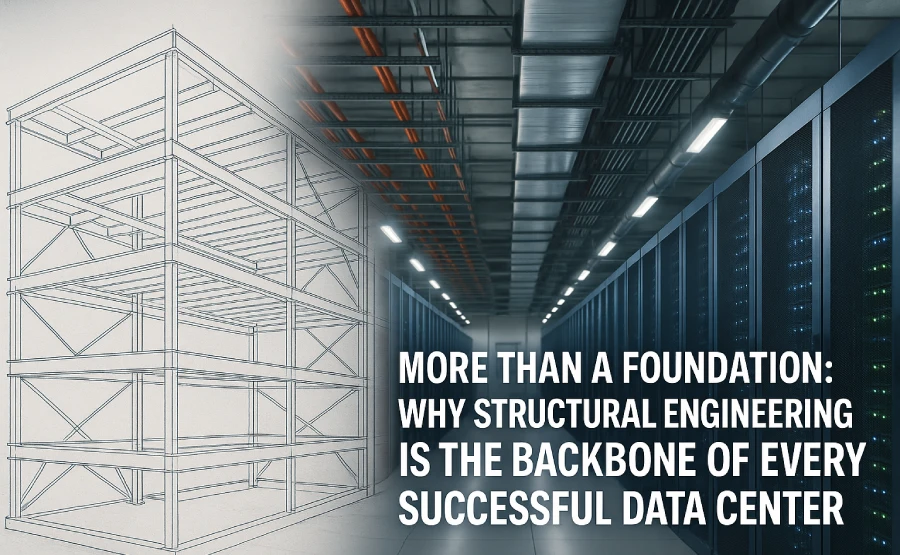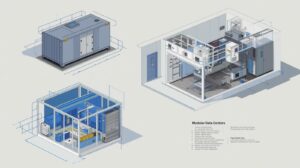In our digital-first world, we talk about uptime, latency, and cloud resilience. But every byte of data, every transaction, and every cloud application lives in a physical building: a data center. While advanced servers, powerful cooling systems, and cybersecurity get the spotlight, the silent guardian of it all is the structure itself.
The importance of structural engineering for data centers cannot be overstated. It’s not merely a part of the construction process; it is the fundamental bedrock that ensures the reliability and longevity of your entire mission-critical investment. This article explores why a robust approach to structural engineering is not a cost center, but the ultimate form of risk mitigation for any Mission Critical Facility.
Redefining the Role: What Does a Structural Engineer Really Do for a Data Center?
The first mistake in data center construction is to view a structural engineer’s role as being the same as for an office building. For a data center, the engineer is a strategist for uptime and resilience. Their responsibilities go far beyond basic design to include:
- Risk Assessor: Identifying and quantifying all potential physical threats to the facility, from seismic activity and extreme weather to the immense, concentrated weight of the equipment itself.
- Performance Guarantor: Designing a structural system that doesn’t just stand up, but actively contributes to the operational goals of the facility—ensuring that vibrations don’t harm sensitive hardware and that the layout can accommodate future technological shifts.
- Multidisciplinary Coordinator: Acting as the crucial link between architectural plans and the complex demands of Mechanical, Electrical, and Plumbing (MEP) systems, ensuring that thousands of cables, pipes, and heavy machinery are supported without compromising structural integrity.
The High Stakes: Why Structural Integrity is a Non-Negotiable Business Imperative
For a standard commercial building, a structural issue is an inconvenience. For a data center, it’s a catastrophe. A lack of proper structural integrity can lead to:
- Catastrophic Downtime: Even minor structural shifts or excessive vibration can cause network failures or server shutdowns, costing millions of dollars per hour.
- Equipment Damage: The hardware within a data center represents a massive capital investment. A structural failure, such as a floor deflection or a seismic event in an unprepared facility, can destroy millions of dollars’ worth of equipment.
- Data Loss: The ultimate consequence of a physical failure is the potential for irreversible data loss, a devastating blow to any modern enterprise.
In the world of mission-critical facility design, the structure is not just a shell; it’s an active component of the reliability chain.
The Core Pillars of Data Center Structural Engineering

A specialized structural engineer focuses on several key pillars that are unique to data center environments.
Mastering Extreme Loads (Load-Bearing Capacity)
Data centers are exceptionally heavy. The load-bearing capacity requirements are immense, involving:
- Dead Loads: The permanent weight of the structure, roofing, and massive MEP equipment.
- Live Loads: The temporary weight of maintenance crews, moving equipment, and other transient forces.
- IT Equipment Loads: The most critical factor. Server racks, UPS systems, and battery banks create incredibly concentrated loads that can exceed 300 pounds per square foot (psf), far beyond a typical commercial building.
Designing for Unseen Forces (Structural Resilience)
A data center must withstand any environmental threat without interruption. Structural resilience involves designing for:
- Seismic Events: Implementing robust bracing for the building and, just as importantly, for non-structural components like server racks, cable trays, and pipes to prevent them from failing during an earthquake.
- Wind and Climate: Analyzing and designing for extreme wind loads, snow loads, and other regional climate risks.
- Vibration: Protecting sensitive hard drives and processors from low-level vibrations caused by nearby traffic, generators, or even the facility’s own cooling equipment.
The Art of Complex Coordination (MEP Coordination)
Effective MEP coordination is crucial. The structural engineer must design a frame that allows for large openings, extensive cable trays, and heavy overhead equipment without creating weak points. This complex three-dimensional puzzle requires deep collaboration to ensure the structural and operational designs are in perfect harmony.
Adherence to Uncompromising Standards (Building Codes & Beyond)
Compliance is the absolute baseline. Engineers must adhere to strict building codes like the International Building Code (IBC) and standards from the American Society of Civil Engineers (ASCE), particularly ASCE 7. However, for a truly resilient data center, expert engineers often design systems that exceed these minimum requirements to ensure operational continuity, not just life safety.
What Are the Key Structural Requirements for a Modern Data Center?
While every project is unique, several key requirements are universal for modern facilities:
- High Floor Loading Capacity: Typically designed for a minimum of 250-350 psf to handle dense IT racks and power equipment.
- Robust Seismic Bracing: Essential for both the building’s frame and all non-structural components.
- Strict Vibration Control: Designing floors with high stiffness to minimize vibrations that can affect hardware performance and longevity.
- Future-Proofing: Designing with enough reserve capacity to accommodate the next generation of heavier and denser servers and liquid cooling systems.
- Strategic Pathways: Pre-planned and structurally supported zones for routing massive amounts of fiber optic and power cabling.
These principles are even more critical in modern data center construction, where modular and skid-based designs introduce unique transportation and load challenges best handled by a specialized skid data center structural engineer.
Frequently Asked Questions (FAQ)
1. What is the difference between a structural engineer for an office and one for a data center? An office engineer designs for human comfort and safety. A data center engineer designs for machine performance, 100% uptime, and extreme load densities. The level of risk analysis, MEP coordination, and understanding of mission-critical requirements is vastly different.
2. How does structural design impact a data center’s PUE or energy efficiency? A well-coordinated structural design allows for more efficient, direct pathways for cooling and power, reducing the energy needed for fans and pumps. It also ensures that heavy, modern cooling units can be placed in optimal locations without structural limitations, directly improving the facility’s PUE.
3. How can good structural engineering future-proof a data center? By designing with higher load-bearing capacity than immediately needed and planning for adaptable structural supports, engineers allow the facility to adopt heavier, denser IT equipment and new cooling technologies in the future without requiring a costly and disruptive structural retrofit.
4. Why is vibration analysis so important for data center equipment? Constant, low-frequency vibrations, even if imperceptible to humans, can degrade the performance and shorten the lifespan of spinning hard disk drives (HDDs) and other sensitive electronic components, leading to premature hardware failure.
Conclusion: An Investment in Uptime, Not Just a Building
Ultimately, the importance of structural engineering for data centers comes down to one thing: protecting your investment and guaranteeing uptime. Viewing this critical discipline as a commodity to be sourced at the lowest cost is a dangerous gamble.
A specialized, experienced structural engineering partner is an investment in the long-term health, scalability, and resilience of your most critical asset. They are the architects of the physical reliability upon which your entire digital world is built.
At Ista Engineers, we provide the specialized structural engineering expertise required for mission-critical facilities. Contact us to ensure your data center is built on a foundation of confidence and resilience.




